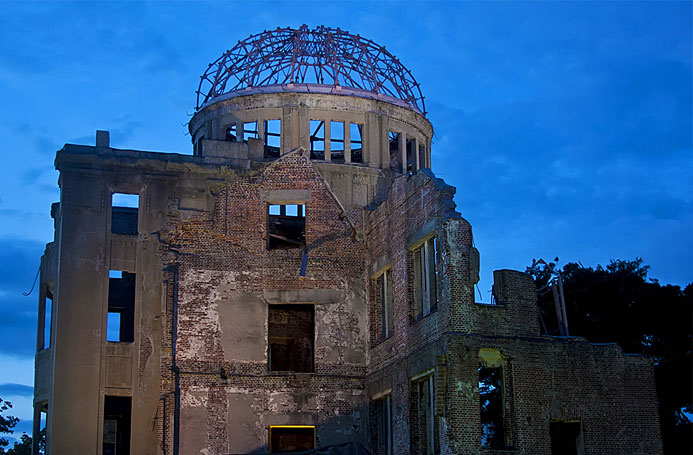
I’ll never forget the day. We finished our morning assembly in the school yard and we were waiting in our classroom when suddenly, a friend by the window shouted — “B-29!” … A flash of light pierced my eyes. The entire building collapsed immediately and we were trapped underneath … When I came to, I couldn’t move…” — eyewitness account of a Hiroshima survivor.
It’s a defining moment when you arrive at Hiroshima, the site of the first nuclear bomb explosion. Today, it is a bustling city with no evidence of past horrors.
Heritage site
The peace memorial park is a triangular area where the A-bomb dome stands. Standing a mere 160 metres from the hypocenter of the explosion, this building was the Industrial promotion hall of the prefecture, and was heavily damaged by the blast. All occupants perished but a section of the building under the central dome miraculously stood! This skeletal structure locally became known as the A-bomb dome. It was declared a UNESCO World Heritage site in 1996.
The Peace memorial park is visited by thousands from across the world. The Children’s Peace Monument was inspired by Sadako, a young girl who was about two years old at the time of the bombing. She developed leukaemia 10 years later. She believed that folding 1,000 origami cranes would grant her wish of staying alive, but she died eight months later. Sadako’s classmates started a fund-raising campaign to build a monument for her and the other children lost to the bombing. On top of a huge arch-like tower stands a statue of a girl holding a paper crane. We then moved towards the huge cenotaph for the A-bomb victims, which is saddle-shaped and bears the Japanese inscription meaning: “Rest ye in peace for the error shall not be repeated.” There is a flame burning continuously below the cenotaph. The Peace bell near the Children’s monument was donated by the Greek Embassy and bears inscriptions in Greek, Sanskrit and Japanese, which translated, read ‘Know yourself”.
Life after the bomb
The east wing of the famous Hiroshima Peace Memorial Museum records the history of the city and the lives of the citizens before and after the bombing. The West Wing displays the personal effects, clothing and watches of the victims. The sight of the charred lunch box of a high school student is moving. The museum condemns the use of the atomic bomb, but is also critical of the actions of the Japanese Imperial army!
Our visit ended on a sombre note as we listened to a talk by a Hibakusha or a bomb survivor, who lost both her parents in the explosion, but wanted to share her experiences so that nuclear weapons are never used again.
After a day of sobering history, we took a train to Miyajima station and then a ferry to this famous island just off the coast of Hiroshima. Miyajima is considered one of the three most scenic destinations in Japan and, in ancient times, was considered so holy that common people could not set foot on itDeer roam all over the pier looking for handouts, and people say they even do the O-jigi, or the famous Japanese custom of bowing!
Miyajima is home to several temples and traditional Japanese inns called Ryokans. The most famous shrine is the Itsukushima jinja, one of Japan’s most photographed attractions. The giant vermillion Torii or gate sits in the middle of the water, and at high tide, looks as if it’s floating. The two main pillars of the Torii are said to be made out of camphor tree trunks. The main shrine is a complex of lacquered buildings.
A different world
We checked in to a traditional Ryokan, with a futon and low seating and a traditional onsen or a hot spring on the ground floor. After an invigorating dip, we were treated to a vegetarian Japanese sit-down meal. Dressed in a Yukata and the geta or wooden clogs, we went to the shrine. The red torii gates were lit up brilliantly, and for a moment, the mountains, sea and the shrine seemed to be seamless. The next day we visited Mt. Misen, the tallest mountain on the island. It’s a 90-minute trek to the top but we ttook the ropeway instead! We bit into a Momiji manju (a local sweet filled with sweet bean paste) at the restaurant near the ropeway station and enjoyed the panoramic views of the Inland Seto Sea. It was a fitting finale to my visit to Hiroshima and Miyajima.
Hiroshima showed me our capacity for inhumanity. Miyajima restored my balance and healed me like only Nature can. Two worlds in one holiday…!
Published in The Hindu Metro Plus, 2008.

